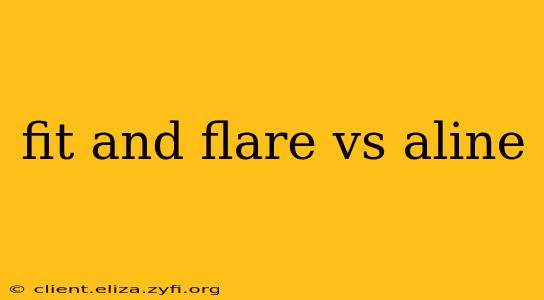Fit and Flare vs. A-Line: Unveiling the Differences Between These Flattering Dress Shapes
Choosing the perfect dress can feel like navigating a minefield of styles, cuts, and silhouettes. Two popular choices that often cause confusion are the fit-and-flare and the A-line dresses. While both are known for their flattering shapes, subtle differences set them apart. This comprehensive guide will delve into the nuances of each style, helping you understand which one best suits your body type and personal style.
Understanding the Fit-and-Flare Silhouette
The fit-and-flare dress, as its name suggests, hugs the body closely through the torso, typically to just below the bust or waist, before flaring out dramatically from the waist down. This creates a defined waistline and a feminine, hourglass shape. Think of it as a streamlined top that gradually expands into a full skirt. The flare can be subtle or dramatic, depending on the design.
Understanding the A-Line Silhouette
An A-line dress, on the other hand, starts at the shoulders and gradually widens towards the hem, resembling the shape of the letter "A." This style is generally more relaxed and less form-fitting than the fit-and-flare, providing a comfortable and versatile look. The flare is typically gentler and less pronounced than in a fit-and-flare.
What's the difference between an A-line dress and a fit-and-flare dress?
This is a frequently asked question, and the key lies in the fit at the waist. The fit-and-flare dress emphasizes the waist significantly more, creating a more defined shape. The A-line dress, while flattering, offers a softer, less structured silhouette. The difference is often subtle, but the fit at the waistline is the most telling distinction.
Which silhouette is more flattering?
Both A-line and fit-and-flare dresses are incredibly flattering on a wide range of body types. The fit-and-flare is particularly effective at accentuating the waist, making it a great option for those who want to highlight their curves. The A-line is more forgiving and universally flattering, especially for those who prefer a less defined waistline or want a more relaxed fit. Ultimately, the "more flattering" silhouette depends on individual preferences and body type.
What are the occasions suitable for each style?
Both styles are incredibly versatile. The fit-and-flare dress, with its more structured and often more polished look, is appropriate for a range of occasions, from formal events to semi-formal occasions, cocktail parties, or even a sophisticated date night. The A-line dress, thanks to its versatility, can work equally well for everyday wear, business casual settings, or less formal events.
Which fabric works best for each style?
The fabric choice can greatly influence the overall look and feel of both dress styles. Fit-and-flare dresses often look stunning in structured fabrics like brocade, tweed, or even heavier silks, that emphasize the defined waist. A-line dresses, however, look equally beautiful in flowing fabrics like chiffon, cotton, or jersey that enhance the easy, breezy silhouette. However, both styles can be created using a wide variety of materials, depending on the desired effect.
What are the best fit-and-flare and A-line dress styles for different body types?
- Hourglass: Both styles work well, but the fit-and-flare can beautifully accentuate the waist.
- Pear: An A-line is a great option as it balances wider hips with a slimmer upper body.
- Rectangle: A fit-and-flare can help create the illusion of curves, whereas an A-line provides a flattering, balanced shape.
- Apple: An A-line dress, especially one with a slightly higher waistline, can be very flattering, creating a balanced silhouette.
Ultimately, the best way to determine whether a fit-and-flare or A-line dress is right for you is to try them on. Consider your body type, the occasion, and your personal style preferences. With so many variations within each style, you're sure to find the perfect dress to flatter your figure and boost your confidence.
